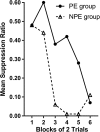Human latent inhibition: Problems with the stimulus exposure effect
- PMID: 29557066
- PMCID: PMC6267522
- DOI: 10.3758/s13423-018-1455-4
Human latent inhibition: Problems with the stimulus exposure effect
Abstract
Latent inhibition (LI) is a startlingly simple effect in which preexposure of a stimulus without consequence retards subsequent responding to a stimulus-consequence relation. The effect was first demonstrated with Pavlovian conditioning in animals and was later suggested to be a marker of human psychopathology such as schizophrenia. Individual differences in LI has supported the continued use of animal models to understand human mental health. In this review, we ask whether there is sufficient evidence to support the continued application of LI from animal models to human psychopathology because of the weak evidence for LI in humans. There is considerable variability in the methods used to assess LI, sustaining different theoretical accounts of the effects observed, which differ from the accepted accounts of LI as demonstrated in animals. The review shows that although there have been many experiments testing human LI, none provide the necessary experimental controls to support the conclusion that retarded responding is caused simply by preexposure to a stimulus, as has been demonstrated with animal models. Establishing this conflict, we set out a framework for future research.
Keywords: Associative learning; Latent inhibition; Masking tasks; Priming.
Figures


Similar articles
-
A demonstration of within-subjects latent inhibition in the human: limitations and advantages.Behav Brain Res. 2003 Jan 6;138(1):1-8. doi: 10.1016/s0166-4328(02)00181-x. Behav Brain Res. 2003. PMID: 12493625
-
A comparison of latent inhibition and learned irrelevance pre-exposure effects in rabbit and human eyeblink conditioning.Integr Physiol Behav Sci. 2002 Jul-Sep;37(3):188-214. doi: 10.1007/BF02734181. Integr Physiol Behav Sci. 2002. PMID: 12435211 Clinical Trial.
-
The latent inhibition model of schizophrenia: further validation using the atypical neuroleptic, clozapine.Biol Psychiatry. 1996 Nov 1;40(9):834-43. doi: 10.1016/0006-3223(95)00573-0. Biol Psychiatry. 1996. PMID: 8896769
-
Latent inhibition in humans: data, theory, and implications for schizophrenia.Psychol Bull. 1995 Jan;117(1):87-103. doi: 10.1037/0033-2909.117.1.87. Psychol Bull. 1995. PMID: 7870865 Review.
-
The relevance of irrelevance to schizophrenia.Neurosci Biobehav Rev. 2005;29(6):989-99. doi: 10.1016/j.neubiorev.2005.01.006. Neurosci Biobehav Rev. 2005. PMID: 15967503 Review.
Cited by
-
Latent inhibition, aberrant salience, and schizotypy traits in cannabis users.Schizophr Res Cogn. 2022 Jan 5;28:100235. doi: 10.1016/j.scog.2021.100235. eCollection 2022 Jun. Schizophr Res Cogn. 2022. PMID: 35028297 Free PMC article.
-
Latent Inhibition in Schizophrenia and Schizotypy.Schizophr Bull Open. 2023 Nov 17;4(1):sgad026. doi: 10.1093/schizbullopen/sgad026. eCollection 2023 Jan. Schizophr Bull Open. 2023. PMID: 39145328 Free PMC article. Review.
-
The relationship between latent inhibition, divergent thinking, and eyewitness memory: A study on attention to irrelevant stimuli.PLoS One. 2025 Jun 23;20(6):e0315158. doi: 10.1371/journal.pone.0315158. eCollection 2025. PLoS One. 2025. PMID: 40549729 Free PMC article.
-
Relationship between behavioral measures of anxiety and latent inhibition in mature rats.Learn Behav. 2019 Mar;47(1):59-65. doi: 10.3758/s13420-018-0331-4. Learn Behav. 2019. PMID: 29926398 Free PMC article.
-
Behavioral and neural mechanisms of latent inhibition.Learn Mem. 2022 Jan 18;29(2):38-47. doi: 10.1101/lm.053439.121. Print 2022 Feb. Learn Mem. 2022. PMID: 35042827 Free PMC article. Review.
References
-
- Allan LG. A note on measurement of contingency between two binary variables in judgment tasks. Bulletin of the Psychonomic Society. 1980;15(3):147–149.
-
- Allan LM, Williams JH, Wellman NA, Tonin J, Taylor E, Feldon J, Rawlins JNP. Effects of tobacco smoking, schizotypy and number of pre-exposures on latent inhibition in healthy subjects. Personality and Individual Differences. 1995;19(6):893–902.
-
- Baker AG. Learned irrelevance and learned helplessness: Rats learn that stimuli, reinforcers, and responses are uncorrelated. Journal of Experimental Psychology: Animal Behavior Processes. 1976;2(2):130.
-
- Baker AG, Mackintosh NJ. Preexposure to the CS alone, US alone, or CS and US uncorrelated: Latent inhibition, blocking by context or learned irrelevance? Learning and Motivation. 1979;10(3):278–294.
-
- Baker AG, Mercier P. Extinction of the context and latent inhibition. Learning and Motivation. 1982;13(4):391–416.
Publication types
MeSH terms
LinkOut - more resources
Full Text Sources
Other Literature Sources

